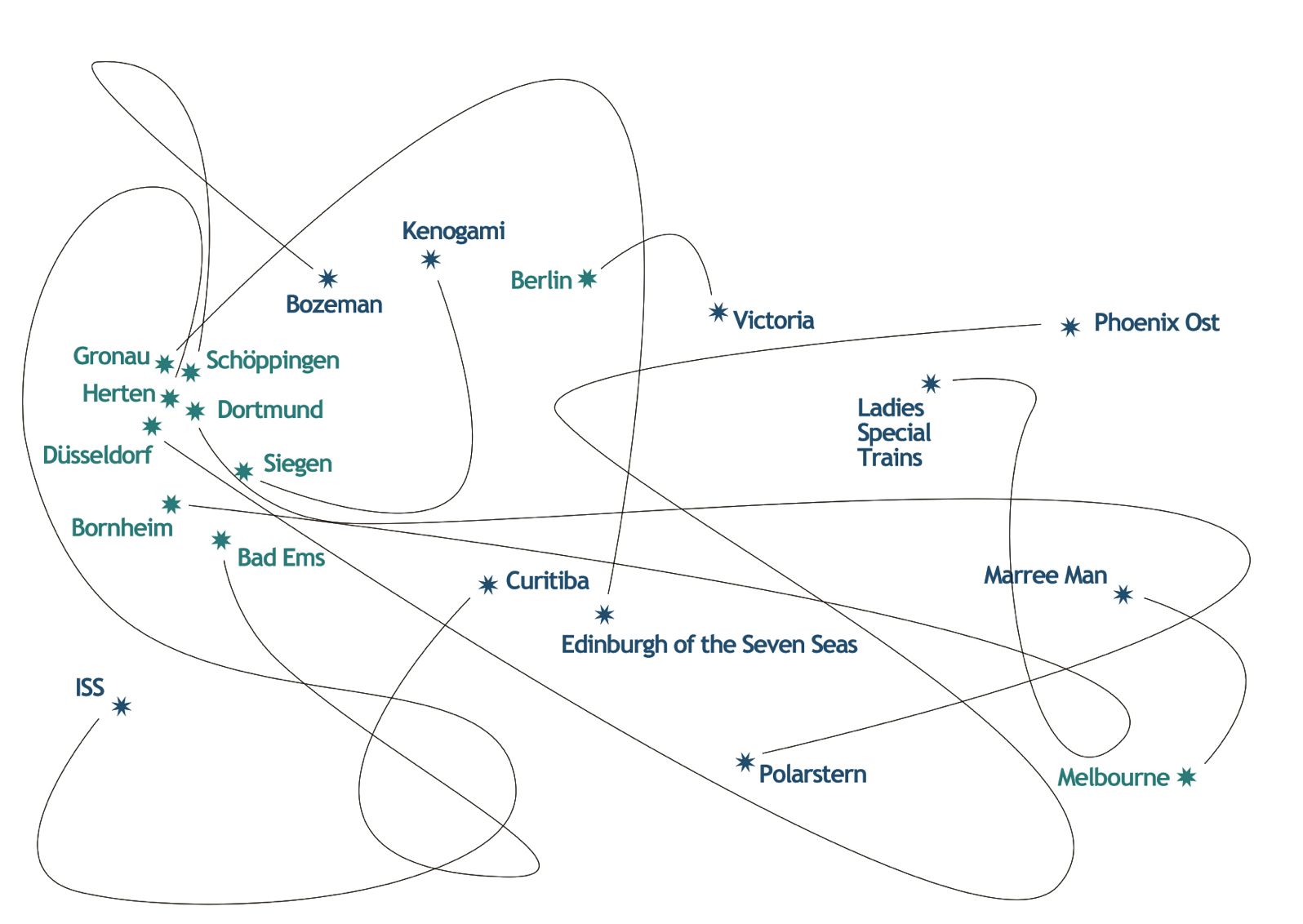Weltweites, partizipatives Klangkunstprojekt
Global participatory sound art project
2013 - 2018
small world wide basiert auf dem Kleine-Welt-Phänomen, nach dem angeblich jeder Mensch auf der Erde durch eine kurze Kette an direkten Bekanntschaften mit jedem anderen Menschen verbunden ist.
Im Jahr 2013 hat die Klangkünstlerin Denise Ritter 10 Audiorekorder an 10 Startpersonen verteilt, mit der Aufgabe, diese jeweils über eine Reihe von ausschließlich persönlichen Bekanntschaften an 10 Zielorte weltweit zu bringen.
Diese sollen von den Teilnehmer*innen - genau wie alle Etappenorte - durch Audio-Aufnahmen dokumentiert werden.
Dies können beispielsweise für den Alltag oder Lebensraum charakteristische Geräusche und Klänge sein, es gibt aber keinerlei Vorgabe.
Die Rekorder dürfen nur an unmittelbare Bekannte weitergegeben werden. Der direkte Weg zum Ziel über fremde Personen ist nicht erlaubt.
Auf diese Art haben sich 10 Routen rund um den Globus gebildet, und rund 30 Stunden an Audio-Aufnahmen aus aller Welt hat die Künstlerin bis heute erhalten.

Die Audio-Aufnahmen zeigen überraschende, globale Gemeinsamkeiten, was die Wahl der Aufnahmeorte und -situationen angeht.
Seit Anfang 2016 realisiert die Künstlerin eine Serie von Klanginstallationen, die sich jeweils auf eine dieser Gemeinsamkeiten fokussieren. Auf diese Art werden - unabhängig von den 10 Routen - jene Teilnehmer*innen miteinander verknüpft, deren Aufnahmeorte und -situationen starke Parallelen aufweisen.
small world wide is based on the small world phenomenon which says that everybody in the world is, through a short chain of direct acquaintances, connected with each other.
In 2013 the sound artist Denise Ritter allocated 10 audio recorders to 10 startup persons, who should aim the recorders, through a chain of personal acquaintances, to reach 10 scheduled destinations. Those places as well as the intermediate steps should be documented by sound recording. These can be for example noises or sounds characteristic for daily life or living space. But no guidelines are given.
It is only allowed to pass on the recorder to direct acquaintances.
The direct way to the destination via a stranger or non-related person is not allowed.
In this way 10 routes around the world arised, and until today the artist received more than 30 hours of sound recordings from all over the world.
The sound recordings share unexpected global similarities concerning the recording places and situations the participants chosed.
Since January 2016 a series of sound installations based on the sound recordings are being gradually realized - each of these concentrates on one of the similarities mentioned.
In this way - independently from the 10 routes - participants are connected with other participants whose recording places and situations show strong parallels.

KLEINE WELT | SMALL WORLD
Der Begriff „Kleine-Welt-Phänomen“ bzw. „small world phenomenon“ wurde in den 60er Jahren vom amerikanischen Psychologen Stanley Milgram geprägt.
Er stellte die Hypothese auf, dass jeder Mensch auf der Erde durch eine kurze Kette an direkten Bekanntschaften mit jedem anderen Menschen verbunden ist.
Für Milgrams Untersuchung sollten 296 Menschen einen Brief an ein und diesselbe Zielperson schreiben. Die Adresse war Ihnen unbekannt, und sie mussten versuchen, den Brief einem ihrer Bekannten weiterzuleiten, der womöglich näher an der Zielperson dran war als sie selbst. Dieser Bekannte und die folgenden sollten wiederum genauso vorgehen.
Innerhalb kurzer Zeit waren die Briefe am Ziel, wobei durchschnittlich 5,2 Stationen zwischen dem Absender und dem Empfänger lagen - und nie mehr als sechs. Das Ergebnis wurde als das Kleine-Welt-Phänomen bekannt - jeder kennt jeden weltweit über maximal sechs Ecken („six degrees of separation“).
Die amerikanische Psychologin Judith Kleinfeld stellte in einer 2002 veröffentlichten Studie fest, dass in Wirklichkeit nur wenige Menschen sehr gut vernetzt sind, denn nach wie vor wird die Realität weltweit sehr stark von sozialen Grenzen, wie z. B. Hautfarbe und Klasse definiert. Soziale Beziehungssysteme folgen ihrer Meinung nach keineswegs mathematischen Modellen.
The term „small-world-phenomenon“ was coined by the American psychologist Stanley Milgram in the 1960ies.
He put forward the hypothesis that every human being on earth is connected with each other through a short chain of direct acquaintances.
For his studies Milgram asked 296 people to write a letter to one and the same target person. The address was unknown to them, and they should try to forward the letter to one of their acquaintances, whom possibly was nearer to the target person than themselves. This acquaintance and the following should proceed in the same way.
Within a short period of time the letters reached their destination, whereby it took an average of 5,2 stations between sender and recipient - never ever more than six. The result got to know as the small-world-phenomenon - no two people are more than six degrees apart („six degrees of separation“).
The american psychologist Judith Kleinfeld noted in a survey published in 2002 that in fact only a few people are well-connected, because still reality worlwide is strongly defined by social borders as color of skin or class. To her opinion social relation systems do not follow mathematical models at all.
© Denise Ritter | VG Bild-Kunst | www.gegenort.com | Impressum | Datenschutz